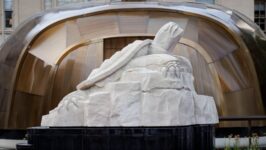
New Indigenous spirit garden opening outside Toronto city hall
A new Indigenous spirit garden will open in Toronto on Monday to honour residential school survivors.
City officials say the garden is Toronto’s response in part to the Truth and Reconciliation Commission of Canada’s Call to Action 82, which calls for governments to install a residential schools monument in each capital city to honour survivors and all the children who did not come home.
Andrew Wesley, a member of the Fort Albany First Nation and residential school survivor, said visitors to the garden can learn not only about the abuse suffered by residential school survivors and intergenerational trauma, but also about the culture and history of Indigenous peoples who live in Toronto and its surrounding area.
“Be open to your heart when you hear our stories. These are sacred stories.”
The public garden, in the southwest corner of Nathan Phillips Square in front of city hall, has as its centrepiece a large turtle sculpture made of limestone. Elements that represent First Nation, Métis and Inuit cultures surround the turtle and include a teaching lodge, a silver voyageur canoe and an inukshuk made out of granite.
The turtle, designed by Anishinaabe artist Solomon King, sits on sculpted boulders in the middle of a reflecting pool, facing the pool’s north wall. The wall displays the names of all 18 residential schools that operated in Ontario.
The $24.9-million project was led by the Toronto Council Fire Native Cultural Centre, a cultural agency that serves the city’s Indigenous community. It officially opens to the public at 2 p.m. on Monday, National Day for Truth and Reconciliation.
A ‘peaceful, contemplative space’
The city says the garden is designed to be a “peaceful, contemplative space.”

Wesley told reporters that the spirit garden contains symbols of significance to Indigenous people in the Toronto area. He has lived in Toronto for nearly 25 years and went to two residential schools, including St. Anne’s Indian Residential School in Fort Albany.
Wesley said Indigenous people are diverse, their cultural symbols vary from place to place and he hopes the garden will teach non-Indigenous people a little bit about Indigenous people. A spirit garden is a good idea for other cities in Canada, he added.
“I believe there should be a symbol in every city, according to tradition… If you go to B.C., then you might have a salmon. If you go up to the North, it would be a polar bear. I think it has to represent the people.”
Garden ‘can reach everyone,’ elder says
Susan Hunter, a member of the Peawanuck First Nation in Northern Ontario and another residential school survivor, said the garden is a place to meditate and take in teachings from elders. Hunter went to St. Anne’s Indian Residential School for seven years.
Hunter said she hopes visitors to the garden gain a better understanding of the diversity of Indigenous cultures in Toronto.
“We’ve been hidden far too long. We should be in the forefront where people understand our ways and our culture,” she said.

Hunter added that it’s important “to know that there are various Indigenous cultures. It’s not just the Crees, it’s not just the Ojibwe or Haudenosaunee, there are other mixtures of people here in Toronto.”
She added that specific Indigenous cultures have, for example, their own dances, singing, syllabics and clothing.
Hunter said the garden’s location will make it accessible.
“I think it’s a really good thing because it’s central. It also can reach everyone from the tourist to the ordinary resident of Toronto,” Hunter said.
The Toronto Council Fire said on its website: “The design of the Spirit Garden revolves around Turtle Island, and offers dedicated places for contemplation, celebration and ceremonies — open, inclusive and welcoming to all.”

A ‘place for reflection,’ mayor says
Toronto Mayor Olivia Chow told the 7th annual Indigenous Legacy Gathering in the square on Friday that the garden is a “permanent memorial and Indigenous cultural space” that recognizes those impacted by residential schools.
The gathering, an annual event in the square leading up to National Truth and Reconciliation Day, celebrates the cultures, traditions and languages of Indigenous peoples, the city says.
Chow said the garden showcases the resilience of Indigenous peoples of Canada.
“It’s a place for reflection, cultural celebration and spiritual ceremonies and is open to all, seeking connections and understanding,” Chow said.

On Monday, there will be a commemorative walk from Indigenous flags in the square to the spirit garden before it opens. The event will include elders, survivors and their families and politicians.
Pat Tobin, general manager of the city’s economic development and culture division, said the project began in 2017, when the Toronto Council Fire Native Cultural Centre told the city that there was an absence of “Indigenous placemaking” in the downtown core.
Tobin said Indigenous placemaking is “claiming and occupying public space that is led by and for and of benefit to the Indigenous community.”
“What you see behind us is probably the single largest piece of Indigenous-led placemaking in the city of Toronto, surely not to be the last, but a really important step forward for both the city of Toronto and certainly Council Fire on behalf of the broader urban Indigenous community in Toronto,” Tobin said.



